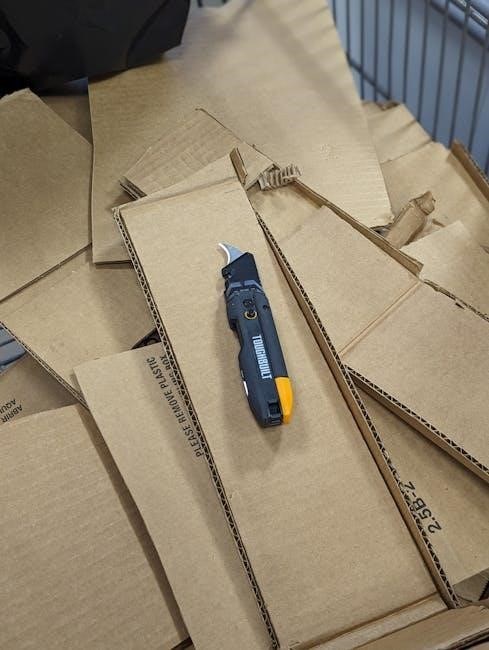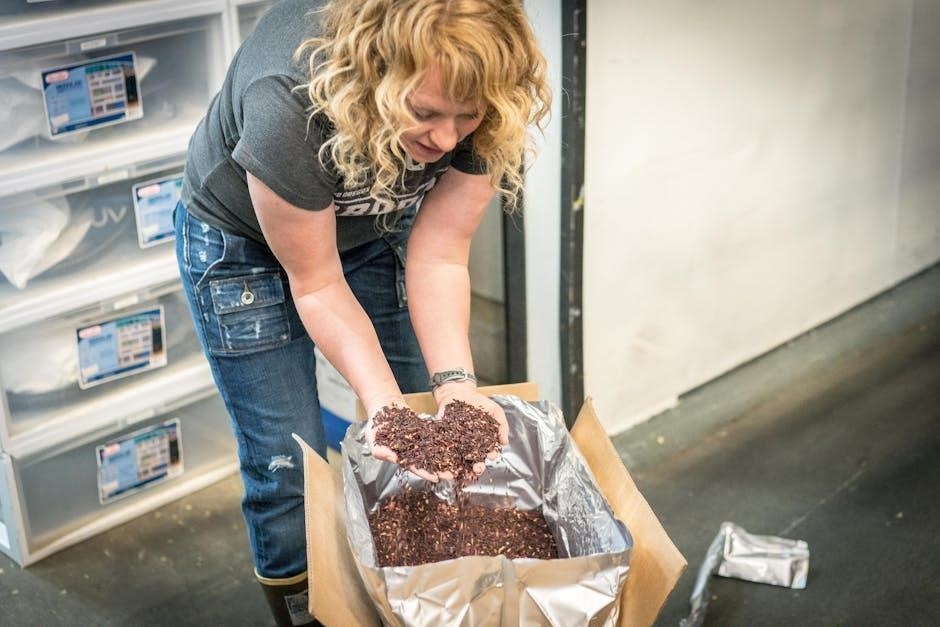Toolbox Talks on manual handling are short, interactive sessions that promote safe practices, reducing workplace injuries and improving overall safety by addressing proper lifting techniques and hazard awareness.
1.1 Why Manual Handling Matters in Workplace Safety
Manual handling is a critical aspect of workplace safety, as it directly impacts employee well-being and operational efficiency. Nearly 25% of workplace injuries stem from manual handling tasks, often affecting the back, hands, and feet. These injuries can lead to long-term health issues, absenteeism, and increased medical costs. Proper manual handling practices not only protect workers but also reduce the financial burden on employers. By addressing manual handling risks, organizations can create a safer environment, improve productivity, and comply with legal requirements. Preventing manual handling injuries through training and awareness is essential for fostering a culture of safety and ensuring the sustainability of a healthy workforce.
1.2 Benefits of Conducting Regular Toolbox Talks
Regular toolbox talks on manual handling provide numerous benefits, including increased worker awareness of safety practices and hazard identification. These sessions foster a culture of safety, encouraging employees to actively participate in preventing injuries. Toolbox talks also ensure compliance with legal requirements and industry standards, reducing the risk of legal penalties. By addressing specific workplace risks and sharing practical tips, these discussions empower workers to adopt safer manual handling techniques. Additionally, they promote open communication, allowing employees to voice concerns and suggest improvements. Regular talks reinforce training, ensuring that safe practices remain a priority. Ultimately, they contribute to a safer, more efficient workplace with fewer injuries and higher productivity.

What is Manual Handling?
Manual handling refers to lifting, pushing, pulling, carrying, or moving objects manually. It involves various physical activities that, if done incorrectly, can lead to injuries and musculoskeletal disorders.
2.1 Definition and Scope of Manual Handling
Manual handling is the act of lifting, lowering, pushing, pulling, carrying, or moving objects manually. It encompasses a wide range of tasks that involve physical exertion and can lead to injuries if not performed correctly. The scope of manual handling includes any activity that requires the use of force to move or support a load, such as carrying tools, lifting materials, or moving equipment. It is not limited to lifting alone but also includes tasks like bending, reaching, or holding objects. Understanding the definition and scope of manual handling is crucial for identifying risks and implementing safe practices in the workplace. Proper techniques and training can significantly reduce the likelihood of injuries and improve overall workplace safety.
2.2 Common Manual Handling Tasks in the Workplace
Common manual handling tasks include lifting materials, carrying tools, pushing equipment, and pulling loads. These tasks are frequent in industries like construction, healthcare, manufacturing, and retail. For example, construction workers often lift heavy materials, while healthcare professionals may manually move patients. In offices, employees might carry files or equipment. Repetitive tasks, such as bending to pick up items or reaching for objects, are also forms of manual handling. These activities, if performed incorrectly, can lead to injuries like back strain or muscle sprains. Recognizing these common tasks is essential for assessing risks and implementing safe practices. Proper training and techniques can help workers perform these tasks safely, reducing the likelihood of harm and improving workplace efficiency.
2.3 Key Factors Influencing Manual Handling Risks
Several factors influence manual handling risks, including the weight and size of the load, the posture required to handle it, and the frequency or duration of the task. Environmental conditions, such as uneven surfaces or limited workspace, also play a role. Task-related factors like repetitive movements or awkward lifting positions increase the likelihood of injury. Additionally, individual factors, such as a worker’s physical fitness, training, and overall health, can impact risk levels. Understanding these factors helps identify high-risk tasks and implement targeted safety measures to reduce injuries. Regular assessments and adjustments to workplace practices are essential to mitigate these risks effectively.

Legal Requirements and Regulations
Legal requirements mandate employers to identify and manage manual handling risks, ensuring a safe work environment. Regulations outline specific duties for employers and employees to prevent injuries.
3.1 Overview of Manual Handling Regulations
Manual handling regulations require employers to identify and manage risks associated with manual tasks. These regulations emphasize conducting risk assessments and implementing control measures to prevent injuries. Employers must provide a safe work environment, proper training, and equipment to reduce manual handling risks. Employees are also obligated to follow safe practices and report hazards. Specific laws, such as the Manual Handling Operations Regulations, outline clear guidelines for assessing and controlling risks. Compliance with these regulations ensures legal adherence and promotes workplace safety, protecting both employers and employees from potential liabilities and injuries; Regular updates to regulations reflect evolving safety standards, making it essential for organizations to stay informed and adapt their practices accordingly.
3.2 Employer Responsibilities Under the Law
Employers are legally required to identify and manage manual handling risks in the workplace. They must conduct thorough risk assessments and implement control measures to minimize hazards. Providing proper training, equipment, and safe work environments is essential. Employers must ensure employees understand safe manual handling practices and use mechanical aids when necessary. They are also responsible for monitoring compliance with safety protocols and updating procedures as regulations evolve. Failure to meet these obligations can result in legal consequences and increased workplace injuries. Employers must stay informed about relevant laws, such as the Manual Handling Operations Regulations, to ensure adherence and protect both employees and the organization from potential liabilities. Proactive management of manual handling risks is crucial for maintaining a safe and compliant work environment.
3.3 Employee Duties and Accountability
Employees have a critical role in maintaining workplace safety by adhering to manual handling guidelines. They must follow safe lifting techniques, report hazards, and participate in training sessions. Employees are accountable for using personal protective equipment (PPE) and mechanical aids when required. They should avoid lifting loads beyond their capacity and seek assistance when necessary. Reporting injuries or near-misses promptly is essential to prevent further incidents. Employees are also responsible for cooperating with employers to implement safety measures and comply with legal requirements. By taking personal responsibility for their actions, employees contribute to a safer work environment and reduce the risk of manual handling injuries. Their active participation in safety practices is vital for the overall success of workplace safety initiatives.

Conducting a Manual Handling Toolbox Talk
Conducting a manual handling toolbox talk involves short, interactive sessions led by supervisors to discuss risks, demonstrate techniques, and ensure worker participation in maintaining safety standards effectively.
4.1 Preparation Tips for an Effective Toolbox Talk
Preparation is key to delivering an effective toolbox talk on manual handling. Start by selecting a quiet, distraction-free location to ensure full engagement. Gather relevant materials, such as visual aids, safety guidelines, and real-life examples of manual handling incidents. Involve supervisors or safety experts to provide authority and insights. Review recent workplace incidents related to manual handling to tailor the discussion to specific risks. Encourage worker participation by preparing open-ended questions or scenarios. Ensure all necessary equipment, such as projectors or handouts, is ready. Finally, rehearse the talk to stay within the time frame and cover all critical points. Proper preparation ensures the session is informative, interactive, and impactful, fostering a safer work environment.
4.2 Key Elements to Cover During the Session
A effective toolbox talk on manual handling should cover essential elements to ensure workers understand the risks and safe practices. Start by defining manual handling tasks, such as lifting, pushing, pulling, and carrying. Emphasize the LITE principle (Load, Individual, Task, Environment) to guide safe lifting practices. Discuss common hazards, like awkward postures or excessive loads, and provide practical tips for reducing strain. Highlight the importance of using mechanical aids when possible. Include real-life scenarios or case studies to illustrate risks and solutions. Encourage open discussion, allowing workers to share experiences or concerns. Conclude by reinforcing company policies and legal requirements, ensuring everyone understands their roles in maintaining a safe environment. Keep the content engaging and relevant to foster active participation and knowledge retention.
4.3 Engaging Workers in the Discussion
Engaging workers is crucial for a productive toolbox talk on manual handling. Encourage open discussions by asking questions and inviting workers to share their experiences or challenges. Use real-life examples or case studies to illustrate key points, making the content relatable. Incorporate visual aids, such as diagrams or videos, to demonstrate proper techniques and hazards. Encourage hands-on participation, like practicing safe lifting methods or identifying risks in their workspace. Foster a collaborative environment where workers feel comfortable asking questions or suggesting improvements. By actively involving workers, you ensure they are invested in the session and more likely to apply the knowledge in their daily tasks. This interactive approach helps reinforce safe manual handling practices and promotes a culture of safety.

Best Practices for Safe Manual Handling
Best practices include using proper lifting techniques, mechanical aids, and load assessment. Maintain posture alignment, bend at knees, and team up for heavy tasks to minimize risks effectively.
5.1 The LITE Principle for Safe Lifting
The LITE principle is a widely recognized framework for safe lifting, standing for Load, Individual, Task, and Environment. It helps assess and mitigate risks during manual handling tasks.
Load: Evaluate the weight, size, and balance of the object. Ensure it is within your lifting capacity and evenly distributed.
Individual: Consider personal factors like strength, fitness, and lifting technique. Workers should know their limits and use proper body mechanics.
Task: Examine the movement required, such as distance, height, and any twisting. Simplify the task if possible to reduce strain.
Environment: Check the workspace for obstacles, uneven surfaces, or limited space that could hinder safe lifting.
By applying the LITE principle, workers can minimize injury risks and perform lifting tasks more safely, aligning with best practices for manual handling.
5.2 Practical Tips for Safe Lifting and Carrying
Safe lifting and carrying require a combination of proper technique and awareness. Always stand close to the load, with feet shoulder-width apart, and face the direction of movement. Bend at the knees, keeping the back straight, and lift with leg muscles rather than the back. Avoid twisting; instead, pivot on your feet. Carry objects at waist height, close to the body, and maintain a firm grip. For large or heavy items, consider using mechanical aids or team lifting. Plan the route beforehand to avoid obstacles. Take regular breaks during repetitive tasks to reduce fatigue. These practical steps significantly reduce the risk of injury and promote efficient manual handling. Consistent practice of these techniques fosters a safer workplace culture. Always prioritize safety over speed to protect yourself and others.
5.3 Using Mechanical Aids to Reduce Risk
Using mechanical aids is one of the most effective ways to minimize manual handling risks. Tools like forklifts, hoists, and trolleys can significantly reduce physical strain and injury risks. Always select the right aid for the task, ensuring it is suitable for the load’s size and weight. Regularly inspect and maintain mechanical aids to ensure they function properly. Train employees on how to use these devices safely and efficiently. Encourage a culture where mechanical aids are prioritized over manual lifting whenever possible. By integrating these tools, workplaces can create a safer environment, reduce fatigue, and improve overall productivity. Proper use of mechanical aids not only protects workers but also enhances operational efficiency. Always consider mechanical solutions first to eliminate or reduce manual handling risks effectively. This proactive approach fosters a safer and healthier workplace culture.

Reinforcing Safe Manual Handling Practices
Regular training, feedback, and monitoring ensure sustained safe manual handling habits. Leadership support and continuous improvement efforts are key to maintaining a strong safety-focused workplace culture.
6.1 The Role of Training in Manual Handling Safety
Training is vital for equipping workers with the knowledge and skills to handle manual tasks safely. It raises awareness of risks and teaches proper techniques to prevent injuries. Regular sessions ensure compliance with legal requirements and reinforce best practices. Interactive and engaging methods, such as demonstrations and toolbox talks, help workers understand and apply safe practices. Training also fosters a culture of safety, encouraging employees to take accountability for their actions. By addressing specific workplace hazards and promoting the use of mechanical aids, training significantly reduces the likelihood of manual handling injuries. Continuous learning ensures workers stay updated on new methods and tools, further enhancing workplace safety.
6.2 Continuous Improvement Through Feedback
Feedback is essential for driving continuous improvement in manual handling safety. Encouraging workers to share their experiences and insights helps identify gaps in current practices. Supervisors should actively seek input on challenges faced during manual tasks and implement adjustments based on this feedback. Regular discussions during toolbox talks provide a platform for open communication, fostering a culture of safety and collaboration. By addressing concerns and refining procedures, feedback loops ensure that safety protocols remain effective and relevant. This iterative process not only enhances compliance with regulations but also strengthens the overall commitment to reducing manual handling risks in the workplace. Continuous improvement through feedback is key to sustaining a safe and efficient work environment.
6.3 Monitoring and Evaluating Safety Practices
Monitoring and evaluating safety practices are crucial for ensuring the effectiveness of manual handling protocols. Regularly observing tasks and reviewing incident reports helps identify trends and areas for improvement. Employers should conduct audits to assess compliance with safety standards and hazard controls. Worker observations and safety metrics, such as injury rates, provide valuable insights. Feedback from employees can also highlight gaps in training or procedures. By continuously evaluating these practices, organizations can refine their strategies, ensuring they remain aligned with legal requirements and industry best practices. This ongoing process not only enhances workplace safety but also fosters a culture of accountability and continuous improvement, ultimately reducing manual handling risks and promoting a safer work environment.
